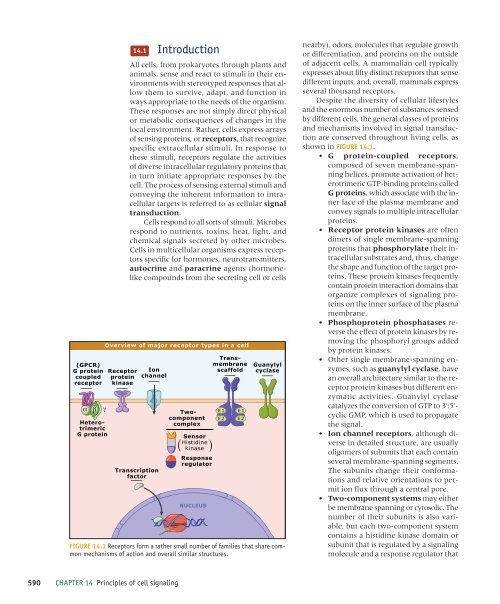Principles of cell signaling - UT Southwestern
Principles of cell signaling - UT Southwestern
Principles of cell signaling - UT Southwestern
Create successful ePaper yourself
Turn your PDF publications into a flip-book with our unique Google optimized e-Paper software.
39057_ch14_<strong>cell</strong>bio.qxd 8/28/06 5:11 PM Page 590<br />
(GPCR)<br />
G protein<br />
coupled<br />
receptor<br />
Heterotrimeric<br />
G protein<br />
14.1<br />
Introduction<br />
All <strong>cell</strong>s, from prokaryotes through plants and<br />
animals, sense and react to stimuli in their environments<br />
with stereotyped responses that allow<br />
them to survive, adapt, and function in<br />
ways appropriate to the needs <strong>of</strong> the organism.<br />
These responses are not simply direct physical<br />
or metabolic consequences <strong>of</strong> changes in the<br />
local environment. Rather, <strong>cell</strong>s express arrays<br />
<strong>of</strong> sensing proteins, or receptors, that recognize<br />
specific extra<strong>cell</strong>ular stimuli. In response to<br />
these stimuli, receptors regulate the activities<br />
<strong>of</strong> diverse intra<strong>cell</strong>ular regulatory proteins that<br />
in turn initiate appropriate responses by the<br />
<strong>cell</strong>. The process <strong>of</strong> sensing external stimuli and<br />
conveying the inherent information to intra<strong>cell</strong>ular<br />
targets is referred to as <strong>cell</strong>ular signal<br />
transduction.<br />
Cells respond to all sorts <strong>of</strong> stimuli. Microbes<br />
respond to nutrients, toxins, heat, light, and<br />
chemical signals secreted by other microbes.<br />
Cells in multi<strong>cell</strong>ular organisms express receptors<br />
specific for hormones, neurotransmitters,<br />
autocrine and paracrine agents (hormonelike<br />
compounds from the secreting <strong>cell</strong> or <strong>cell</strong>s<br />
Overview <strong>of</strong> major receptor types in a <strong>cell</strong><br />
Receptor<br />
protein<br />
kinase<br />
Ion<br />
channel<br />
Transcription<br />
factor<br />
Twocomponent<br />
complex<br />
(<br />
Sensor<br />
Histidine<br />
kinase<br />
Response<br />
regulator<br />
NUCLEUS<br />
Transmembrane<br />
scaffold<br />
(<br />
E1<br />
E2<br />
E1<br />
E2<br />
Guanylyl<br />
cyclase<br />
FIGURE 14.1 Receptors form a rather small number <strong>of</strong> families that share common<br />
mechanisms <strong>of</strong> action and overall similar structures.<br />
nearby), odors, molecules that regulate growth<br />
or differentiation, and proteins on the outside<br />
<strong>of</strong> adjacent <strong>cell</strong>s. A mammalian <strong>cell</strong> typically<br />
expresses about fifty distinct receptors that sense<br />
different inputs, and, overall, mammals express<br />
several thousand receptors.<br />
Despite the diversity <strong>of</strong> <strong>cell</strong>ular lifestyles<br />
and the enormous number <strong>of</strong> substances sensed<br />
by different <strong>cell</strong>s, the general classes <strong>of</strong> proteins<br />
and mechanisms involved in signal transduction<br />
are conserved throughout living <strong>cell</strong>s, as<br />
shown in FIGURE 14.1.<br />
• G protein-coupled receptors,<br />
composed <strong>of</strong> seven membrane-spanning<br />
helices, promote activation <strong>of</strong> heterotrimeric<br />
GTP-binding proteins called<br />
G proteins, which associate with the inner<br />
face <strong>of</strong> the plasma membrane and<br />
convey signals to multiple intra<strong>cell</strong>ular<br />
proteins.<br />
• Receptor protein kinases are <strong>of</strong>ten<br />
dimers <strong>of</strong> single membrane-spanning<br />
proteins that phosphorylate their intra<strong>cell</strong>ular<br />
substrates and, thus, change<br />
the shape and function <strong>of</strong> the target proteins.<br />
These protein kinases frequently<br />
contain protein interaction domains that<br />
organize complexes <strong>of</strong> <strong>signaling</strong> proteins<br />
on the inner surface <strong>of</strong> the plasma<br />
membrane.<br />
• Phosphoprotein phosphatases reverse<br />
the effect <strong>of</strong> protein kinases by removing<br />
the phosphoryl groups added<br />
by protein kinases.<br />
• Other single membrane-spanning enzymes,<br />
such as guanylyl cyclase, have<br />
an overall architecture similar to the receptor<br />
protein kinases but different enzymatic<br />
activities. Guanylyl cyclase<br />
catalyzes the conversion <strong>of</strong> GTP to 3′:5′-<br />
cyclic GMP, which is used to propagate<br />
the signal.<br />
• Ion channel receptors, although diverse<br />
in detailed structure, are usually<br />
oligomers <strong>of</strong> subunits that each contain<br />
several membrane-spanning segments.<br />
The subunits change their conformations<br />
and relative orientations to permit<br />
ion flux through a central pore.<br />
• Two-component systems may either<br />
be membrane spanning or cytosolic. The<br />
number <strong>of</strong> their subunits is also variable,<br />
but each two-component system<br />
contains a histidine kinase domain or<br />
subunit that is regulated by a <strong>signaling</strong><br />
molecule and a response regulator that<br />
590 CHAPTER 14 <strong>Principles</strong> <strong>of</strong> <strong>cell</strong> <strong>signaling</strong>
















